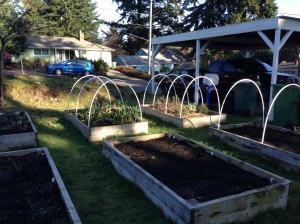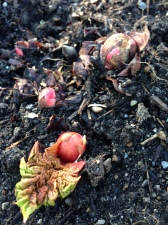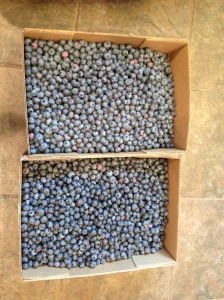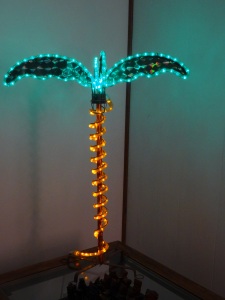So I finally managed to get a few hours of semi-warm daylight to get out in the yard and do some gardening. It’s starting to get embarrassing, the beautiful garden I had all summer looks like hell now. Thankfully the hubs went out a day or two before Christmas and took out all the dead sunflowers. I’m pretty sure I’ll be growing 8′ tall sunflowers in that bed for the next 5 years. So many seeds were scattered by the squirrels, it was unreal. Oh well, there are worse things to have in your garden than volunteer sunflowers.
My efforts were focused on weeding and getting the rhubarb into the front bed. I had 2 rhubarb plants in my herb bed that are semi-productive, but just need more space, so they moved. And we also moved a sad rhubarb that was hanging out in our backyard around to the front bed as well. I have no idea if the backyard one was a red or green or anything about it because it gets run over by the lawn mower on a regular basis. I did not split the ones from the herb bed, because I wasn’t sure I knew how to do it, and the hubs did split the one from the back, though it was more by accident and out of irritation than anything intentional.
So how are you supposed to grow rhubarb?
Rhubarb is about as hardy as they come, from the reading I’ve done. They are productive in the spring and summer and go dormant in the fall and winter. The dormant time is when it’s ideal to transplant and split the rhubarb crown. Most people wait until early spring when the rhubarb buds have broken through the ground to determine where to split the root. You should try to keep buds with each portion of root. The crown/root ball can get pretty large; I had one that was easily 2 feet in diameter, and most likely I could have just split it down the middle and then into quarters and it would produce well. Many references say that rhubarb should not be harvested the first year after splitting, and that only crowns at least 4 years old should be split.
Maybe I’ll split them up next year, or maybe I won’t. A family can only eat so much rhubarb…
Rhubarb prefers well-drained soil. Its arch nemesis is crown rot, which can occur if the soil doesn’t drain at all. During the summer you should water your rhubarb on a regular basis, but it’s not a guzzler like some plants are (tomatoes). I’ve read in multiple places that rhubarb does fine in pots, but I have not found that to be true; mine was a sad, pathetic thing that never produced anything until it got some space.
Harvesting is probably the trickiest part of rhubarb growing, because there are RULES, yes, rules to harvesting. So, don’t harvest too much the first few years, and never harvest all the stalks. One reference said once the stalks start getting skinny the harvesting should stop as well.
The leaves of rhubarb are poisonous, only the stalk is edible. And really, the stalk is only edible after it’s cooked. Also, you shouldn’t cut the stalks off the plant, they should always be pulled out. Cutting the stalks can also lead to crown rot via decay of the remaining stalk attached to the crown.
Things to do with rhubarb
- Rhubarb-and-strawberry crumble or pie. It’s an ideal pairing because both ripen late spring/early summer, around May to June in the Pacific Northwest. Rhubarb provides a nice tang that complements the sweeter strawberry nicely.
- Rhubarb jam. This was a pleasant surprise in our household. I always assumed it needed to be combined with another fruit to tame it, but took a leap of faith and made some. It’s really good, sweet and tangy, great for toast and sandwiches.
- Bluebarb (Blueberry-Rhubarb) jam. This was also a big hit at our house this year. I’m forever in debt to my friend from high school, who dug out her mom’s old recipe for it. It tastes amazing and is a great way to use your extra pounds of blueberries.
- Rhubarb can be chopped and frozen to be used during the winter for desserts as well.
Bluebarb Jam (from the Pintler family)
I think this recipe may have come from a small batching cookbook, but I’m not sure which one. This is a canning recipe and requires processing the jam in a hot water bath. This recipe is not intended to teach anyone proper canning technique, please refer to the USDA’s website for Home Food Preservation to learn how to can properly and safely.
Ingredients:
3.5 cups chopped frozen rhubarb (I used some frozen and some fresh)
0.5 cup water
2.25 cups blueberries (fresh or frozen)
1 Tablespoon lemon juice
1 package dry pectin
5.5 cups white granulated sugar
1. When chopping the rhubarb, make sure to chop it up well. Large pieces will make your jam turn out stringy.
2. Mix rhubarb and water in a non-reactive pot and bring to a boil.
3. Cover, reduce heat to low or medium low, and simmer the rhubarb for 5 minutes. Stir a couple times to prevent sticking and burning.
4. Add blueberries, lemon juice and pectin. While continuously stirring, bring mixture to a boil.
5. Add sugar, and while still continuously stirring (the life of a jam maker), bring it back to a boil and boil hard for 1 minute.
6. Remove from heat and pour the jam into sterilized jars. Process the jars in a hot water bath for 15 minutes, then let them sit for 5 minutes with the heat turned off in the water.
7. Check your seals, label the jars, and you’re good to go. I recommend using this one as gifts for hostesses and as Christmas presents.



